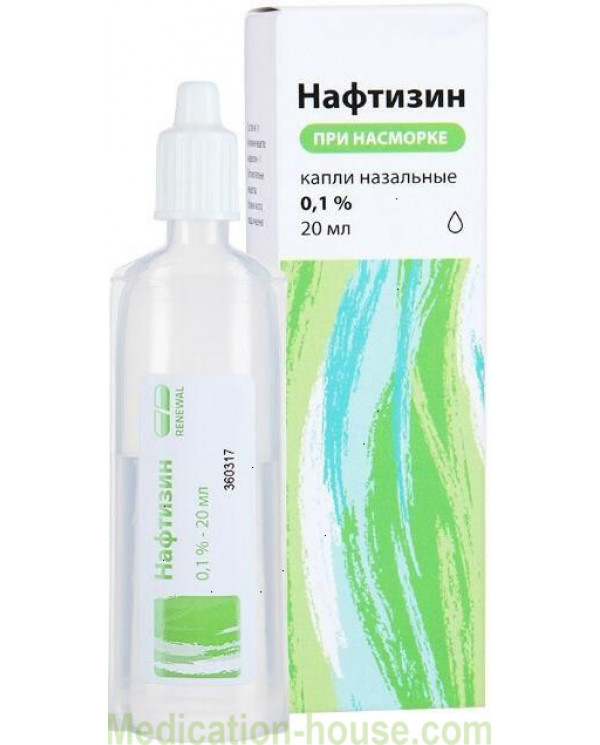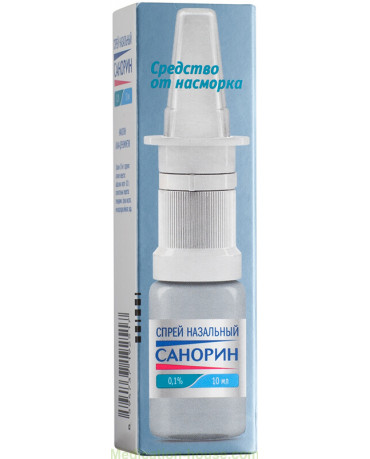Instruction for Naphtizin
Reed more and buy Naphtizin on this page
Composition and form of release
Naphtizin solution is a clear, colorless liquid. May be slightly colored. Drops in the nose are contained in glass bottles of 5 or 10 ml, can be in plastic dropper bottles of 10, 15 or 20 ml. The kit may include a dropper cap. It is enclosed in a cardboard box.
The composition includes the active component naphazoline, and the preparation also contains auxiliary ingredients: boric acid and purified water.
Children's Naphtizin contains 0.5 mg of the active substance, a drug for adults - 0.1 mg.
What helps Naphtizin?
Doctors advise Naphtizin to be used not only for the common cold, but also for other diseases. Treatment of children with this drug is not excluded. Drops in the nose are prescribed for diseases such as:
acute stage of rhinitis;
if laryngitis occurs in acute or chronic form;
eustachitis;
sinusitis provoked by allergic swelling of the nasal mucosa;
when the laryngeal mucosa reddened after irradiation or a productive intervention.
If there is a diagnostic or surgical operation, Naphtizin can also be used to significantly reduce or eliminate bleeding, edema and other inflammatory manifestations.
Pharmacological properties
Nasal drops have a vasoconstrictor and vasoconstrictive effect. The drug belongs to the group of alpha-adrenergic agonists, which affect the alpha-adrenergic receptors of the mucous tissue. Naphtizin helps secretion from the nasal passage.
The main pharmacological properties include:
reduction of inflammatory reactions;
pupil expansion of the eyes;
elimination of swelling of the mucous tissues;
narrowing of the nasal vessels;
relief of nasal breathing in rhinitis;
strengthening local anesthetics.
The active substance of the drug is naphazoline. Additional components are boric acid and purified water.
Instruction for use
According to the instructions for use, Naphtizin nasal drops are applied only topically by instillation into each nasal passage. The dose depends on the severity of the disease and is selected individually.
The average dosage regimen is determined by age (in each nasal passage):
Adults and children from 15 years: 3-4 times a day for 1-3 drops or 1 spray injection (0.05-0.1% solution);
Children 6-15 years old: 1-3 times a day, 2 drops or 1 spray injection (0.05% solution);
Children 1-6 years old (for drops) and 2-6 years old (for spray): 1-3 times a day for 1-2 drops or 1 spray injection (0.05% solution).
The course of treatment for rhinitis should not exceed in adults 5-7 days, in children - 3 days.
Contraindications
You can not use the drug in such cases:
Chronic rhinitis, including atrophic rhinitis;
Severe atherosclerosis;
Arterial hypertension;
Hyperthyroidism (thyrotoxicosis);
Severe eye diseases, including angle-closure glaucoma;
Diabetes;
Tachycardia;
Concomitant use with monoamine oxidase inhibitors, as well as a period of up to 14 days after the end of therapy;
Age up to 1 year (for 0.05% drops), up to 2 years (for 0.05% spray), up to 18 years (for 0.1% drops and spray);
Hypersensitivity to the drug.
With special care, Naphtizin is prescribed to children from one to six years old.
Side effects
During the use of Naphtizin, side effects may occur in the form of headache, nausea, tachycardia, reactive hyperemia, increased blood pressure, swelling of the nasal mucosa.
Long-term use of the drug can also cause “Naphtizin addiction” and drug rhinitis.
Pregnancy and lactation
The use of naphazoline during pregnancy and lactation (breastfeeding) is possible only according to strict indications in those cases where the expected therapeutic effect for the mother outweighs the potential risk of side effects in the fetus or child.
Reviews
Helena
I used Naphtizin for a whole month every year (seasonal allergy), many times a day (strong manifestations), ignoring the instructions (there were no forces). No harm happened. As soon as the flowering of “my” grass ended, the runny nose ceased (quickly and completely) and there were never residual effects from a prolonged edema or from Naphtizin. Used for many years. Believe it or not, don’t believe it. I don’t confuse anything and I write the pure truth.
Terms of sell
You don't need a prescription to buy Naphtizin.


